What is the lowest-carbon protein?
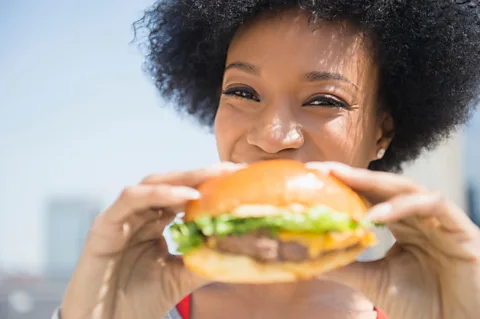 Alamy
AlamyFinding protein-rich foods that are good for the climate can be complex. Isabelle Gerretsen digs into the data to understand which food choices can help us curb emissions.
When it comes to reducing our individual carbon emissions, one of the most impactful steps we can take is to eat more sustainably. Global food production is responsible for 35% of all human-caused greenhouse gas emissions. While animal products account for the bulk of our dietary emissions, they provide only 20% of the world's calories.
Animal products, such as dairy, eggs, fish and meat, are known to be good sources of protein, and getting the right amount of protein is essential for our bodies to grow and repair (Read more about how much protein we really need to consume).
For those who want to eat a low-carbon diet that is also nutritious, getting the right level of protein can be challenging. The picture is complicated by the huge range of products available to us, many of which assert that they are "carbon neutral" or "sustainable" without always backing up these claims.
So, what would a protein-rich, low-carbon diet really look like? Just how bad for the climate are meat and dairy? How much more sustainable is it to only eat plant-based proteins, such as tofu, chickpeas and peas? Is it better to cut out cheese or chicken? Which animal-free alternatives have the lowest emissions' output?
BBC Future set out to answer these questions, using data from the largest ever analysis of food systems, compiled by Joseph Poore, a researcher at the University of Oxford, and Thomas Nemecek, who studies the lifecycle of food at Swiss research institute Agroscope.
Meat
According to the analysis, beef generates 49.9kg of CO2 equivalent, or CO2e, per 100g of protein, equivalent to the amount in four steaks. The proteins with the second-highest greenhouse gas (GHG) footprint are lamb and mutton, which generate 19.9kg of CO2e per 100g.
What is CO2e?
CO2 equivalent, or CO2e, is the metric used to quantify the emissions from various greenhouse gases on the basis of their capacity to warm the atmosphere – their global warming potential.
"There's so much emphasis on beef that people often forget about other types of meat and their impacts," says Anne Bordier, director of sustainable diets at the World Resources Institute.
Cows, sheep and goats are all ruminants, animals with more than one stomach chamber that belch out methane when they digest their food. Although shorter-lived in the atmosphere, methane is a highly potent gas that has a global warming impact 84 times higher than carbon dioxide (CO2) over a 20-year period.
In addition to livestock's high methane output, greenhouse gases are emitted to produce and transport animal feed and run the livestock farms, says Sophie Marbach, a physicist and researcher at the National Centre for Scientific Research in France who carried out an analysis of the carbon footprint of meat and dairy proteins in 2021.
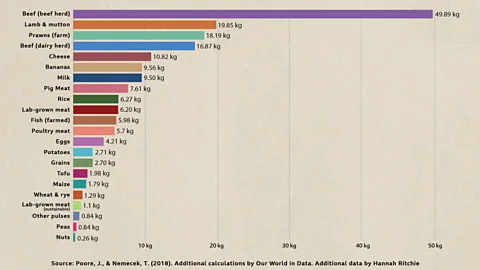 Poore, J., & Nemecek, T. (2018
Poore, J., & Nemecek, T. (2018Beef from a dairy herd has a lower greenhouse gas footprint than meat from a beef herd because you get more food in return for all the resources you invest in the cow (feed, land, water and fertiliser), says Bordier. "[In addition to beef], these cows produce milk, which also tends to be used as feed [for other animals]... So it's more efficient overall," she says.
Dairy cows usually produce high milk yields for about three years, after which they are slaughtered and their meat is used for beef.
Meat from small, non-ruminant animals, such as chicken, turkey, rabbit and duck, has a much lower GHG footprint than beef and lamb. Chicken, for example, has a GHG footprint almost nine times lower than beef's – generating 5.7kg of CO2e per 100g of protein.
That's "quite low", says Sarah Bridle, professor of food, climate and society at the University of York in the UK. "It is really similar to farmed fish and eggs."
Pork's GHG footprint (7.6kg) is about 6.5 times lower than beef's and 1.4 times higher than poultry's (5.7kg).
Dairy
It is cheese, not chicken or pork, that generates the third-highest emissions in agriculture, after lamb and beef.
"There's this consensus that 'being vegetarian is great', but then we sort of forget that cheese is actually pretty carbon intensive," says Marbach, noting that this is due to cows' high methane output and the fact that they require "a lot of inputs for not much output".
The GHG footprint of cheese (10.8kg of CO2e per 100g of protein) is almost twice as high as chicken's and also higher than pork and eggs (4.2kg of CO2e).
The dietary emissions can vary greatly depending on the type of cheese you're eating. Harder cheeses, such as parmesan, are more carbon-intensive than soft cheeses because they are made with more milk, says Bridle. Soft cheeses contain more water – there's 50% more water in cottage cheese than in cheddar, for example, she says.
You might also like:
The GHG footprint of cow's cheese is similar to that of goat's or sheep's milk cheeses "because they're all ruminants," says Bridle. "But cow's cheese is probably the most efficient because dairy cows produce vast amounts of milk." According to data from the UK's Department for Environment, Food and Rural Affairs, a dairy cow produced an average of 8,200 litres (1,800 gallons) last year.
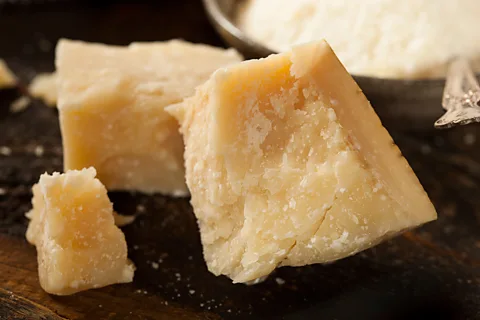 Alamy
AlamyYoghurt, meanwhile, is surprisingly low-carbon, 2.7kg of CO2e per 100g of protein, as not much milk is needed to produce it (much less than in the case of cheese) and there are a number of by-products, such as cream and butter, which means the GHG footprint is distributed across numerous food items,says Marbach.
Plants
Animal products are responsible for 57% of global food-related emissions, compared to plant-based foods which contribute 29% of the total.
The UK's Climate Change Committee (CCC) has recommended a 20% reduction in meat and dairy consumption by 2030, rising to 35% by 2050 for meat, to meet the country's climate goals.
The lowest emissions option would be to adopt a vegan diet and cut out meat and dairy altogether. If the whole world went vegan, global food-related emissions would fall by up to 70% by 2050, according to a study by the Oxford Martin School at the University of Oxford.
A diet rich in peas, pulses and nuts can be incredibly low-carbon. Producing 100g of protein from peas emits just 0.4kg of CO2e. This is almost 90 times less than getting the same amount of protein from beef. Other pulses, such as lentils, have a GHG footprint of 0.8kg of CO2e. Tofu production, meanwhile, generates 2.0kg of CO2e per 100g – these emissions are mostly linked to the clearance of land for soy production, says Bridle.
By crossbreeding wild chickpeas with cultivated varieties, US company Nucicer has created high-protein chickpea powder, which it says also lowers the CO2e of the crop. The powder can be used as gluten-free flour in pasta and baked goods.
By increasing the protein content, Nucicer is able to produce more protein per acre and reduce the overall amount of energy and water needed, says Kathyrn Cook, the company's chief executive and cofounder. "That really helps with the environmental impact of our protein sources," she says. Chickpeas are also highly water-efficient and fix nitrogen from the air into the soil, which is vital for plant growth, she adds.
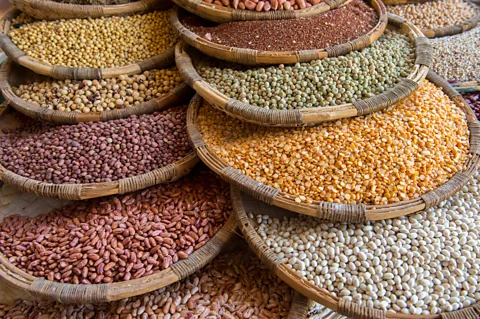 Wolfgang-Kaehler/Getty-Images
Wolfgang-Kaehler/Getty-ImagesFish and seafood
When it comes to fish and seafood, it is more difficult to calculate the GHG footprint. It can vary greatly depending on the species and how it is caught.
Farmed prawns have a much higher footprint (18.2kg of CO2e per 100g) than farmed fish (6.0kg of CO2e). This is because mangrove forests, which store huge amounts of carbon, are often destroyed and converted into prawn farms.
But farmed bivalves, including mussels, oysters, scallops and clams, have a much lower GHG, about six times lower than farmed prawns and roughly 3.5 times lower than farmed fish,says Jessica Gephart, assistant professor in environmental science at the American University in Washington DC.
In 2021, Gephart and her colleagues analysed the environmental impact of seafood across a range of factors, including greenhouse gas emissions, pollution and freshwater use.
Farmed bivalves scored the best across the board. However, bivalves caught in the wild did not perform nearly as well when it came to greenhouse gas emissions – they emit five to 10 times more emissions as their farmed counterparts, says Gephart.
Farmed bivalves don't require animal feed as they filter nutrients from the water and can be harvested without a large amount of energy. Wild bivalves are often caught by dredging – which involves towing large, rigid nets along the seafloor. It's a carbon intensive process which disturbs carbon stored in the sediment and results in the release of CO2, which acidifies the ocean.
One study estimates that seabed dredging produces as much as one billion tonnes of CO2 annually – equivalent to global aviation emissions and greater than those of Germany.
Lab-grown protein
From cellular meat, which uses cells harvested from live animals, to plant-based meat made from soy or pea protein, and cow-free dairy produced using precision fermentation, we now have a huge range of meat and dairy alternatives to choose from if we wish to avoid animal products.
But how do they compare to traditional meat and dairy, when it comes to emissions?
According to a 2020 study by Raychel Santo, a researcher at the Johns Hopkins Center for a Livable Future, plant-based meat generates 1.9kg of CO2e per 100g, while cellular meat produces 5.6kg, compared to beef's GHG footprint of 25.6kg. While emissions for cellular meat were significantly lower than traditional meat, they were five to 21 times higher than emissions from plant proteins, such as pulses, tofu and peas, Santo's research found.
A large proportion of cellular meat's footprint comes from the energy required to manufacture the products, says Santo. The cells harvested from animals are grown in bioreactors, which are highly energy intensive.
"Plant-based meat substitutes have smaller GHG footprints than most farmed meats and cell-based meat, but wild tuna (1.2kg), insects (0.9kg), tofu (1.2kg) and less processed pulses (0.4kg) and peas (0.3kg) have the lowest footprints of all protein-rich foods," says Santo.
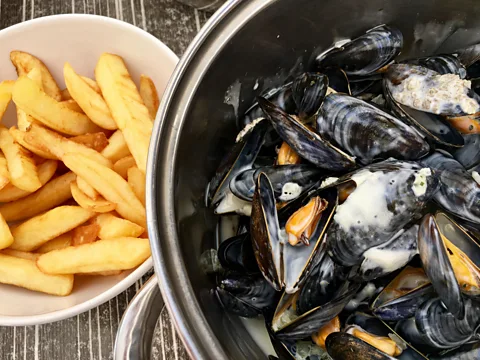 Alamy
AlamyThe footprint of cellular meat is substantially lower than that of beef and lamb, according to research by Hanna Tuomisto, associate professor in sustainable food systems at the University of Helsinki in Finland.
According to Tuomisto's analysis, completely replacing traditional meat with cultured meat would result in a massive 78-98% reduction in GHG emissions, a 99% reduction in land use and 45% reduction in energy use.
Animal-free proteins produced using precision fermentation have a lower emissions output than those in cultured meat, says Tuomisto. Precision fermentation – also known as recombinant protein production – involves inserting specific DNA sequences into non-animal cells, such as bacteria, yeast or other fungi, which allow them to produce proteins that are identical to those found in traditional dairy and meat.
These microorganisms are simpler than the animal cells used in cellular meat, says Tuomisto, which leads to several advantages. They have a faster metabolism and "produce more proteins with less inputs", she says, adding that, unlike cultured meat, they don't require heating as they produce heat themselves while duplicating. This means that their overall GHG emissions are significantly lower.
US company Perfect Day is using this technology to produce animal-free dairy alternatives, including ice cream and milk. The whey that Perfect Day produces has a GHG footprint of 0.3kg of CO2e per 100g of protein, 35 times lower than milk protein (9.5kg of CO2e), says Liza Schillo, the company's director of sustainability and social impact.
According to a life cycle assessment, compared to the total protein in milk, Perfect Day's whey protein is 91-97% lower in GHG emissions, part of which is due to a 29-60% lower energy demand.
"If our animal-free whey protein is used in just 5% of the dairy products on US shelves today, we would save the equivalent of the greenhouse gas emissions from 140,000 roundtrip flights between San Francisco and New York and enough energy to power Washington DC for six years," says Schillo.
There are also companies, such as Solar Foods, that are producing meat substitutes made from bacteria fed on hydrogen. The Finnish company has produced a yellow protein powder from microbes that are fed gases, including CO2, hydrogen and oxygen, which will be used as an additive in foods or as a medium for growing cultured meat.
These gas-fermented proteins are the lowest-carbon meat alternatives "as long as they are using renewable energy", says Tuomisto. Creating hydrogen from water, as Solar Foods does, requires large amounts of electricity. If renewables are used to generate the electricity, the overall GHG emissions of gas-fermented proteins would be very similar to plant-based proteins, she says.
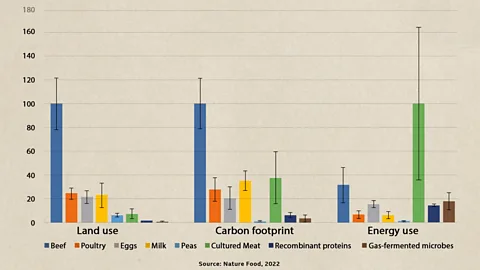 Nature Food, 2022
Nature Food, 2022This investigation has revealed that there are many more ways than one to reduce the emissions from your food choices while getting ample quantities of protein. While cutting the amount of animal products in your diet is a powerful way to reduce emissions, there are other swaps that make a difference too.
If one didn't want to give up animal protein entirely, for instance, the next best thing would be to adopt a diet that consists only of eating small animals (chicken, duck, rabbit), eggs and yoghurt, according to Marbach's research.
By sticking to this "low CO2, high-protein diet", a person can reduce their individual carbon footprint by up to 50%, says Marbach. Adopting a vegetarian diet, which contains a lot of dairy products, especially cheese, is not nearly as effective as the "low CO2" option, says Marbach. It will only reduce a person's food GHG footprint by 20%, according to her analysis.
But it is clear that minimising our reliance on animal products will help lower our overall footprint. In fact, the UN's Intergovernmental Panel on Climate Change (IPCC) says this is critical if the world is to meet its long-term climate goals and limit global warming to 1.5C.
Despite the overwhelming choice of supermarket products claiming to be sustainable, there are a few choices we can be sure will benefit the climate. By swapping beef and lamb for tofu or chickpeas, or checking how the fish and seafood we eat is caught, we can feel confident that our food choices are really helping curb emissions.
* You can learn about the impact of meat subsitutes have on the planet in this podcast by our colleagues on The Climate Question.
--
